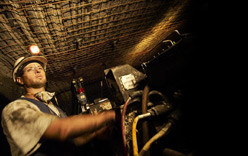PLANNING
There is no obvious point at which to start the planning process, as long as the process is exhaustive. Production tonnage is obviously a major consideration affecting the plan at some point. Occasionally there may be a specific tonnage required and this becomes the major factor in planning, but more generally the requirement is to produce the maximum tonnage at minimum cost within whatever other constraints exist. It is important to remember that constraints can exist at any point from the first access to the lease area, through development of longwall blocks and from the coal cutting machine all the way to the point of use of the product. There is no point in installing a high capacity longwall system if:
- longwall blocks cannot be developed in time to install longwall equipment and at a cost allowing the mine to operate economically overall;
- the coal haulage system cannot clear the coal from the mine at the same rate as the longwall can produce; each leg of the haulage system should have a capacity at least equal to and preferably slightly greater than the preceding section (storage bins can be used to separate sections, but underground bins are seldom large enough to contain much more than one shear off a longwall, so surface stockpiles are usually the only effective separation locations);
- the mine transport system cannot deliver supplies at the required rate;
- the mine ventilation is inadequate to handle the dust or gas produced, even with the addition of a gas drainage system;
- the coal preparation plant (if applicable) cannot handle the same tonnage;
- the transport system from mine to user (rail, road, port, shipping) cannot handle the finished product tonnage;
- there is not a sufficiently skilled labour force available (ready trained or to be trained) to operate the equipment;
- environmental considerations prevent high production levels; or
- there is no market for the final product at a price greater than the costs involved in supply.
Most of these constraints can usually be overcome or at least reduced at a cost, usually involving capital expenditure well before any income is produced. Consideration of all these factors may require numerous plans to be considered and the optimum result in some cases may be to design for less than the maximum tonnage possible when the longwall equipment alone is considered. Even if financial models indicate a high capacity system is the optimum, including high "up front" capital expenditure, it may not be feasible simply because the "up front" finance is not available – a mine has to live within its means, the same as everybody.
In planning it is essential that sufficient time is allowed to examine all available alternatives and full analysis of production and financial models. A modern longwall is a long term commitment and flexibility is desirable because conditions may change greatly during the life of the equipment (financial conditions may vary and machinery developments may change constraints even if all mining conditions are well known in advance). A full analysis of results is essential as it may well be the case that a high initial capital cost can be more than offset by later savings in maintenance/repair costs and/or reduced lost production time by purchasing better quality equipment at the start i.e. the lowest initial cost equipment may not prove to be the cheapest in the long run.
While this module relates to longwalls largely in isolation it is essential to remember in planning that longwall operations are preceded by many other operations from exploration through to development and then, once a longwall begins production, the longwall face is only the start of a long chain of functions in the process of providing a supply to the user.

